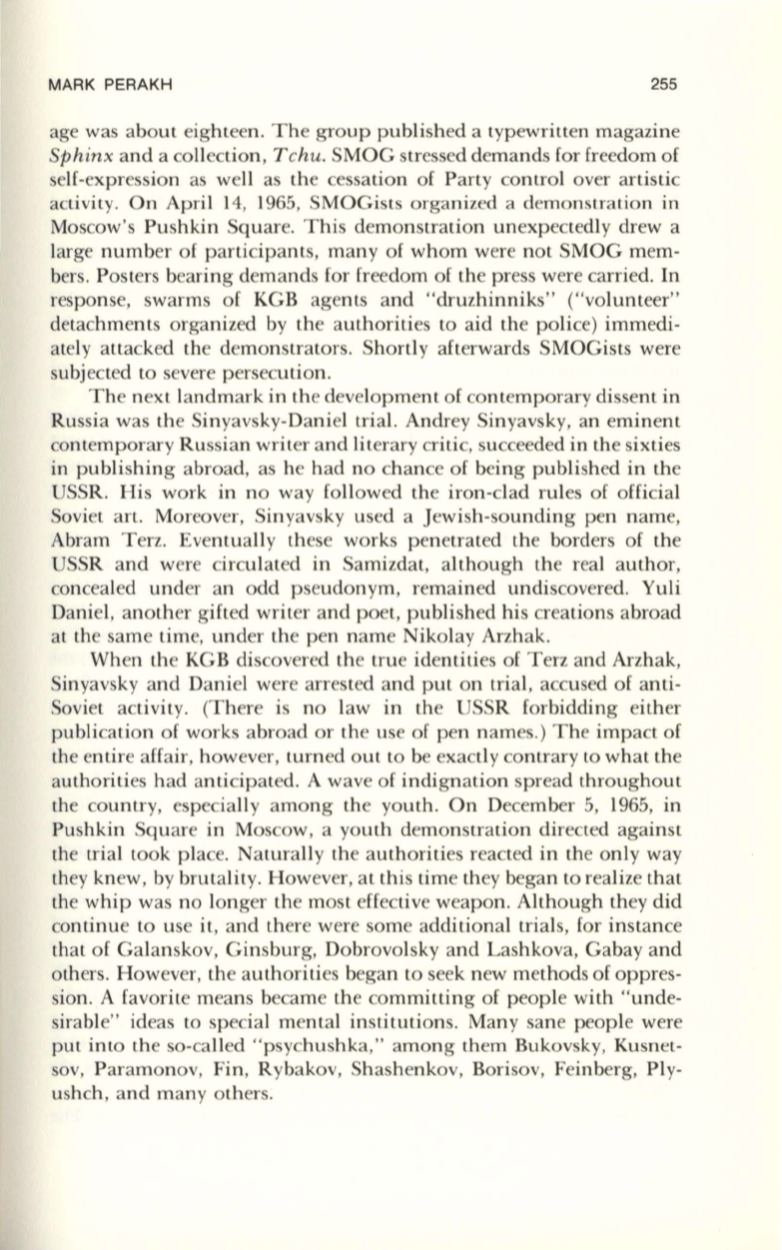
MARK PERAKH
255
age was about eighteen. The group published a typewritten magazine
Sphinx
and a collection,
Tchu.
SMOG stressed demands for freedom of
self-expression as well as the cessation of Party control over artistic
activity. On April 14, 1965, SMOGists organized a demonstration in
Moscow 's Pushkin Square. This demonstration unexpectedly drew a
large number of participants, many of whom were not SMOG mem–
bers. Posters bearing demands for freedom of the press were carried. In
response, swarms of KGB agents and "druzhinniks" ("volunteer"
detachments organized by the authorities to aid the police) immedi–
ately attacked the demonstrators. Shortly afterwards SMOGists were
subjected to severe persecution.
The next landmark in the development of contemporary dissent in
Russia was the Sinyavsky-Daniel trial. Andrey Sinyavsky, an eminent
contemporary Russian writer and literary critic, succeeded in the sixties
in publishing abroad, as he had no chance of being published in the
USSR. His work in no way followed the iron-clad rules of official
Soviet art. Moreover, Sinyavsky used a Jewish-sounding pen name,
Abram Tefl. Eventually these works penetrated the borders of the
USSR and were circulated in Samizdat, although the real author,
concealed under an odd pseudonym, remained undiscovered. Yuli
Daniel, another gifted writer and poet, published his creations abroad
at the same time, under the pen name Nikolay Arzhak.
When the KGB discovered the true identities of Terz and Arzhak,
Sinyavsky and Daniel were arrested and put on trial, accused of anti–
Soviet activity. (There is no law in the USSR forbidding either
publication of works abroad or the use of pen names.) The impact of
the entire affair, however, turned out to be exactly contrary to what the
authorities had anticipated. A wave of indignation spread throughout
the country, especially among the youth. On December 5, 1965, in
Pushkin Square in Moscow, a youth demonstration directed against
the trial took place. Naturally the authorities reacted in the only way
they knew, by brutality. However, at this time they began to realize that
the whip was no longer the most effective weapon. Although they did
continue to use it, and there were some additional trials, for instance
that of Galanskov, Ginsburg, Dobrovolsky and Lashkova, Gabay and
others. However, the authorities began to seek new methods of oppres–
sion . A favorite means became the committing of people with "unde–
sirable" ideas to special mental institutions. Many sane people were
put into the so-called " psychushka," among them Bukovsky, Kusnet–
sov, Paramonov, Fin, Rybakov, Shashenkov, Borisov, Feinberg, Ply–
ushch, and many others.


